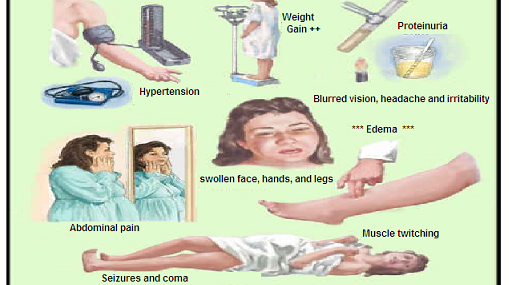Eclampsia Causes Symptoms and Treatment
What is eclampsia?
Eclampsia (эклампсия) is a complication of pregnancy in women with preeclampsia that is characterized by convulsive seizures, headache and drowsiness. It usually occurs somewhere between late second trimester (after the 20th week of gestation) and first week postpartum. Less common symptoms include sudden unexplained coma or hypertension (occur in 38% of cases).
The etiology of Eclampsia is unidentified. Currently no tests are available to accurately distinguish women who will develop preeclampsia and those who will not. However, Eclampsia develops in about 10% of all women with preeclampsia. Eclampsia is a life threatening condition for both the mother and baby, and if left untreated, it can even be fatal.
Eclampsia often presents with one or more convulsive seizures, with each lasting at least 60-75 seconds. During a convulsive seizure the patient’s face may become distorted, with bilateral exophthalmos (proptosis of both eyes), and drooling. Respiration ceases and cyanosis may develop for a minute or two. Convulsive seizures in a woman with preeclampsia may be divided into 2 phases. Phase I only lasts a few seconds (15-20 seconds) and begins with hemifacial spasm (facial twitch or bell’s palsy) and blepharospasm. The body becomes rigid (dystonia), leading to involuntary rigid muscle contractions.
Phase II lasts for a minute. It starts in the jaw, moves to the facial muscles (face and eyelids), and then spreads throughout the body. Skeletal muscles begin alternating between contracting and relaxing in rapid sequence. A coma, lasting for a few seconds or for longer periods of time, follows Phase II. After the period of unconsciousness, the patient may regain some consciousness, and she may become extremely agitated and even violent or combative. However, the patient will have no recollection of the event. In most cases, the patient will have no memory of the past 2-3 hours preceding the seizure. A period of hyperventilation occurs after the generalized tonic-clonic seizure. Respiratory compensation for the respiratory and lactic acidosis that develops during the phase of an apneic event is quite fast (within minutes), this results in a relative reduction in PaCO2.
Complications of eclamptic seizures may include tongue biting, aspiration, head injury, and bone fractures.
Symptoms
What are the symptoms of eclampsia?
Common symptoms of Eclampsia include:
- Convulsive seizures during which the muscles twitch (muscle twitching). Other signs include bilateral exophthalmos and drooling
- Drowsiness during the day
- Headaches and irritability
- Abdominal pain
- Swollen face, hands and feet (edema)
- Hypertension
- Blurred vision and visual disturbances
- Unexplained coma
What are the signs of impending eclampsia?
In addition to swelling, proteinuria, and hypertension (occur in 6-10% of all cases), preeclampsia symptoms can include:
- Unexplained rapid weight gain due to fluid retention (edema). Fluid retention can cause your face, limbs, hands, feet, or belly to look distended.
- Abdominal and lower back pain.
- Severe headaches
- Reflex changes
- Dizziness and the sensation of lightheadedness
- Excessive vomiting and nausea
- Blurred vision
- Reduced urine output or anuria
Causes
What are the causes of eclampsia?
Eclampsia is a life-threatening medical condition associated with preeclampsia that occurs during pregnancy. The causes of Eclampsia and preeclampsia that occur during pregnancy aren’t well-understood. Although preeclampsia occurs primarily in primigravida women, a woman who have or have had severe preeclampsia in a previous pregnancy is almost seven times more likely to develop preeclampsia in a later pregnancy. Other predisposing factors for seizures during pregnancy include preexisting hypertension or cardiovascular disease, kidney disease and headaches
Treatment
What are the treatment options for eclampsia?
Possible treatments for eclampsia may include:
Hospitalization, early administration of anticonvulsive medication, such as magnesium sulfate might be used to cap a seizure. Alternatively, a single IV bolus of diazepam at a dose of 5 mg at a rate of 1 to 5 mg/min can also be used to control a seizure
Drug treatment of hypertension in pregnancy. Methyldopa (Aldomet) is recommended as first line therapy in women with chronic hypertension to restore healthy blood pressure levels (below 130 mmHg). Therapy of acute hypertensive crisis in pregnancy can include IV hydralazine, labetalol and nifedipine (an oral medication).
Close monitoring and prenatal checkups
Ambulatory care or outpatient care is provided on an outpatient basis. This can include:
Lifestyle modifications, such as reducing salt (sodium chloride) intake, reducing sugar intake, drink plenty of fluids (drink 6-8 glasses of water a day), going on a high protein diet and rest, sleeping or lying on your left side is recommended to keep your expanding body weight from placing pressure on major blood vessels
If the preeclampsia is mild, it may be possible to wait until at least 39 weeks to deliver
Next steps management
How to diagnose eclampsia?
Patient Observation and continuous electronic fetal heart rate monitoring using a wireless fetal monitoring prototype technology. For high-risk patients, the fetal heart rate should be determined at least every 15 minutes during the second stage of labor
Doppler ultrasound is useful in diagnosing preeclampsia and eclampsia, it is used to measure the blood flow in the uterine arteries and to collect information about the maternal-fetal circulation by examining placental blood flow and placental vascular resistance on the maternal and fetal sides of the placenta
Monitoring and constant attendance of the physician (or obstetrician) is essential to collect blood pressure, pulse, respiration, and reflexes. The data obtained during the investigation must be recorded every 15 minutes
Monitoring patient complications and concerns, such as visual disturbances, blurred vision, confusion, abdominal pain, and vaginal bleeding
Laboratory tests include CBC, BUN, creatinine, urine analysis. Other laboratory tests that may be indicated include: liver function tests, prothrombin time (PT), and x-ray imaging to rule out pulmonary edema
References
Verified by: Dr.Diab (November 30, 2017)
Citation: Dr.Diab. (November 30, 2017). What is Eclampsia? Causes Symptoms and Treatment. Medcoi Journal of Medicine, 13(2). urn:medcoi:article15749.














There are no comments yet
Or use one of these social networks